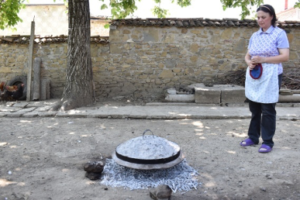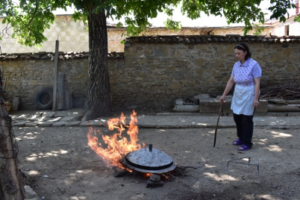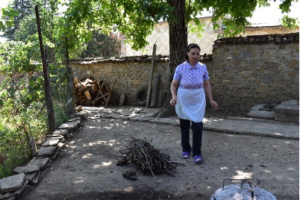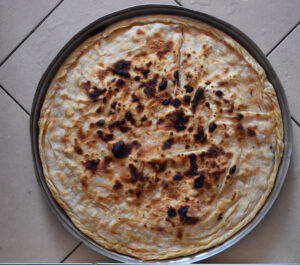Baking in a saç (a covered, large shallow pan), is the most traditional way of baking dishes in the Korça district. It is used to bake lakrori, pies, meat, and desserts.
First, a base is built to fix the saç. The saç has a semi-spherical or dome shape made of sheet metal and has a metal rod atop. It is made by metalsmiths and serves to bake various dishes, prev those of dough. The base is made from stones or bricks stacked about 25-30 cm from the ground. A bundle of kindling wood or brushwood is placed in the center of this base (small and dry tree twigs and branches), which is lit to heat the saç.
Usually, small pieces of kindling stock are used to prevent large flames which send out a lot of heat. Such a fire gives a unique flavor to the dishes cooked in the saç. After lighting the fire, the saç is placed on the stones awaiting till all kindling stock is burned out (this process produces heavy smoke). This fire is always covered with a layer of ash to keep the heat longer. Further, while the kindling pieces are burning, the fire is stirred with a wooden stick to ease the burning out and create embers.
The lakrori pan or other dishes is first placed on the ground and the saç is put over it. This helps to take up heat from above. Afterward, while the embers burning has lessened, the perustia is placed on it. Perustia is an iron tripod structure resting over three iron legs. The pan is placed on the perustia and the heated saç is placed atop. The embers are stirred every so often with a wooden rod to release the heat. Using this rod, the heat is spread over an area beyond the pan diameter in order to bake the whole lakrori.
When lakrori is baked in the saç in hot weather, and there is excessive heat, the saç is occasionally removed from lakrori. In cold weather, when the heat is spread out because of winds, it may be necessary to light a fire once more to win embers back and drop them on top of the saç.
Saçi is removed from time to time to check the baking process and to prevent the dish from getting charred.
With the help of a knife, the bottom crust of the lakrori is raised slightly sideways now and again to check whether the whole lakrori is baked properly. Once it is baked, the saç is removed and so to the pan which is held with mitts and left to cool down.
It is common practice that, as soon as the baking of saç is over, the perustia is placed over the saç, to boost abundance in the house.





